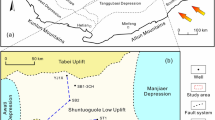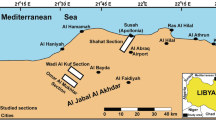Abstract
Petrographic study of the Sinjar and Khurmala Formations at the Zagros and Taurus Folded Zones, in northern Iraq led to the recognition of 11 carbonate microfacies that can be grouped into seven facies associations. These facies associations deposited within outer shelf, fore-reef, reef, back-reef, lagoon, shoals/bars and channels, and tempestite subenvironments of a composite isolated carbonate platform. The digenetic imprints on the recognized microfacies are prominent and dominated by micritization, dissolution, cementation, neomorphism, dolomitization, compaction, stylolitization, and precipitation of some authigenic minerals such as pyrite, glauconite, and gypsum. Isopach and depositional facies maps of the Sinjar–Khurmala successions show three depocenters in two subbasins in the study area, two of them are elongated and coincide with the Zagroside and the Taurides trends, whereas the third accords with the trend of the Sinjar graben. The reconstruction of the history of the Sinjar and Khurmala carbonates revealed four stages of basin development within two subbasins. The first stage represents the initial deposition of the Sinjar and Khurmala Formations that was preceded by the deposition of the deep marine part of the underlying Kolosh Formation. This depositional phase is characterized by submarine fans and basinal sediments. Both subbasins were partially separated by a ridge or a series of paleohighs, which had been inherited from relieves of the Cretaceous paleosurface. During the second depositional stage, the Sinjar basin is developed by growth of another reef build-up to the southeast with a general direction from southwest near Kirkuk area to the northeast near Sulamani area. During the third depositional stage, the basin was developed through the growth of isolated carbonate platform extending from the Kirkuk to the Duhok. Such platform was drowned during the transgression that covered the northern part of the Kolosh basin and southwestern part of the Aaliji basin. The final depositional stage was represented by a still stand period, when the sea level was stilled, and led to the upgrading growth during the early Highstand system tract of the carbonate shelf . As a result, during this stage, the reef facies were prograded seaward and replaced by the back-reef facies to indicate the end of Highstand during the late regression stage.





















Similar content being viewed by others
References
Al-Bassam KS, Karim SA (1992) Depositional history and paleogeography of the Upper Cretaceous—Paleogene phosphorite-bearing sequence, Western Desert, Iraq. Iraqi J Geol 25(1):142–167
Al-Banna NY, Al-Mutwali MM, Al-Ghrear JS (2006) Facies analysis and depositional environment of Khurmala Formation in Bekhair Anticline–Dohuk area, North Iraq. Iraqi J Earth Sci 6(2):13–22
Al-Barzanji ShJ (1989) Microfacies study of the Khurmala Formation from selected sections in north and north east Iraq. Unpublished M.Sc. thesis, Salahaddin University, 113p
Al-Eisa ME (1983) Study of the foraminifera and depositional environment of fossil in the Khurmala Formation, Shaqlawa area. Unpublished M.Sc. thesis, Mosul University, 94 p
Al-Qayim B, Nisan B (1980) Sedimentary facies analysis of a Paleocene mixed carbonate-clastic sequence, Haibat-Sultan ridge, northeast Iraq. Iraqi J Sci 30:525–558
Al-Qayim B, Al-Shaibani SH, Nisan B (1988) Stratigraphic evolution of Paleogene sequence, Haibat-Sultan ridge, northeastern Iraq. J Geol Soc Iraq 21(2):51–66
Al-Qayim B (1993) Petrofacies analysis and tectonic evolution of Zagroside flysch suites from northeastern Iraq. In: Kumon, Ku (eds) Petrology of sandstones in relation to tectonics. V.S.P, The Netherlands, pp 33–34
Al-Qayim B (1995a) Sedimentary facies anatomy of Khurmala Formation, Northern Iraq. Iraqi Geol J 28(1):36–46
Al-Qayim B (1995b) Evolution of flysch basin along the Northeastern margin of the Arabian plate. In A.K. Abed and others (Ed), Geology of Jordan and adjacent areas. Geocom (III), Amman, p. 347–372
Al-Qayim B, Al-Shaibani S (1995) Lithostratigraphy of Cretaceous–tertiary transect, Bekhma Gorge, Northeast Iraq. Iraqi Geol J 28(2):127–136
Al-Sakry SI (2006) Sequence stratigraphy of the Paleocene–Lower Eocene succession, Northeastern Iraq. Ph.D. thesis, Baghdad University, 240 p
Al-Sharhan AS, Nairn AEM (1997) Sedimentary basins and petroleum geology of the Middle East. Elsevier, The Netherlands, 843 p
Al-Surdashy AM, Lawa F (1993) Stratigraphy, microfacies, and depositional environment of Sinjar Formation in selected sections, Northeast Iraq. Special issue, Proceeding of 2nd scientific conference, Salahaddin University
Aqrawi AAM, Goff JC, Horbury AD, Sadooni FN (2010) The petroleum geology of Iraq. Scientific Press Ltd., UK, 424p
Bellen Van RC, Dunnington HV, Wetzel R, Morton D (1959) Lexique Stratigraphique, Interntional. Asie, Iraq, v. 3c. 10a, 333p
Bergman KL, Westphal H, Janson X, Poiriez A, Eberli GP, Westphal H (2010) Controlling parameters on facies geometries of the Bahamas, an isolated carbonate platform environment. In: Riegl B, Eberli GP (eds) Carbonate depositional systems: assessing dimensions and controlling parameters. Springer, New York, pp 38–64
Beydoun ZR (1991) Arabian plate hydrocarbon geology and potential—a plate tectonic approach. AAPG Stud Geol 33:77
Boudagher MK (2008) Evolution and geological significance of larger benthic foraminifera. Elsevier, New York, 560 p
Dunham RJ (1962) Classification of carbonate rocks according to depositional texture. In W.E. Ham (Ed), Classification of carbonate rocks—a symposium. American Association of Petroleum Geologists, Memoir 1, pp. 108–121
Einsele G (2000) Sedimentary basins. Evolution, facies, and sediment budget, 2nd edn. Springer, Germany, p 792
Embry AF, Klovan JE (1972) A late Devonian reef tract on Northeastern Banks Island, NWT. Can Petrol Geol Bull 19:730–781
Enos P, DJ Lehrmann, JY Wei, YY Yu, JF Xiao, DH Chaikin, M Minzoni, AK Berry, P Montgomery (2006) Triassic evolution of the Yangtze Platform in Guizhou Province, People’s Republic of China. Geological Society of America Special Paper 417p
Flugel E (2010) Microfacies of carbonate rocks, 2nd edn. Springer, Germany, 976 p
Folk RL (1962) Spectral subdivision of limestone types. In W.E. Ham (Ed.), Classification of carbonate rocks—a symposium. American Association of Petroleum Geologists, Memoir 1, p. 62–84
Friedman GM (1959) Identification of carbonate minerals by staining methods. J Sed Petrol 29:87–97
James NP (1984) Shallowing-upward sequences in carbonates. In R.G. Walker (Ed), Facies models: Geological Association of Canada, Geoscience Canada, Reprint Series 1, p. 213–228
Jassim SZ, JC Goff (2006) Geology of Iraq. Dolin, Czech Republic, 341 p
Kaddouri N (1982) Late Turonian/Early Campanian sediments in Iraq. J Geol Soc Iraq 15(1):9–18
Kassab I (1975) Planktonic foraminiferal ranges of the subsurface Lower Tertiary, Northern Iraq. J Geol Soc Iraq 11:119–159
Kenter JAM, Harris PM, Della Porta G (2005) Steep microbial boundstone-dominated platform margins—examples and implications. Sediment Geol 178(1–2):5–30
Lehrmann DJ, Pei DH, Enos P, Minzoni M, Ellwood BB, Orchard MJ, Zhang JY, Wei JY, Dillett P, Koenig J, Steffen K, Druke D, Druke J, Kessel B, Newkirk T (2007) Impact of differential tectonic subsidence on isolated carbonate platform evolution: Triassic of the Nanpanjiang Basin, south China. American Association of Petroleum Geologists Bulletin 91 (3), 287–320
Numan NMS (2000) Major Cretaceous tectonic events in Iraq. Rafidain J Sci 11(3):32–52
Numan N, Al-Azzawi N (1993) Structural and geotectonic interpretation of vergence directions of anticlines in the foreland folds of Iraq. Yarmouk Univ 2(2):57–73
Pomar L (2001) Types of carbonate platforms: a genetic approach. Basin Res 13:313–334
Schlager W (2005) Carbonate sedimentology and sequence stratigraphy. Concepts in sedimentology and paleontology no. 8. Society of Economic Paleontologists and Mineralogists p. 13–51
Schroeder JH (1988) Spatial variations in the porosity development of carbonate sediments and rocks. Facies 18:181–204
Sharbazheri KM, Ghafor I, Muhammed Q (2009) Biostratigraphy of the Cretaceous/Tertiary boundary in the Sirwan Valley (Sulaimani Region, Kurdistan, NE Iraq). Geol Carpath 60(5):381–396
Sharbazheri KM, Ghafor I, Muhammed Q (2011) Biostratigraphy of the Cretaceous/Paleogene boundary in Dokan area, Sulaimaniyah, Kurdistan Region, NE Iraq. Iraqi Bull Geol Min 7(3):1–17
Sharland PR, R Archer, DM Casey, RB Davies, SH Hall, AP Heward, AD Horbury, MD Simmons (2001) The chrono-sequence stratigraphy of the Arabian Plate. GeoArabia Special Publication. GeoArabia Special Publication 2, Bahrain, 369p
Sibley DF, Gregg JM (1987) Classification of dolomite rock textures. J Sed Petrol 57(6):967–975
Wilson JL (1975) Carbonate facies in geologic history. Springer Verlag, Germany, 471p
Wright VP (1984) Peritidal carbonate facies models: a review. Geol J 19:309–325
Acknowledgments
Thanks are due to Drs. Zuhair D. Al-Sheikh, Khaldoun S. Al-Bassam, Adnan M. Aqrawi, and Kheder Z. Alsagri for reading the manuscript. Thanks are also extended to Mr. Adnan al-Samaraei for the constructive discussions and valuable information.
Author information
Authors and Affiliations
Corresponding author
Rights and permissions
About this article
Cite this article
Tamar-Agha, M.Y., Salih, A.L.M. & Al-Zaidy, A.A.H. Depositional setting and basin development of the Paleocene—Lower Eocene Sinjar and Khurmala formations, Northern Iraq. Arab J Geosci 8, 9441–9467 (2015). https://doi.org/10.1007/s12517-015-1871-y
Received:
Accepted:
Published:
Issue Date:
DOI: https://doi.org/10.1007/s12517-015-1871-y




